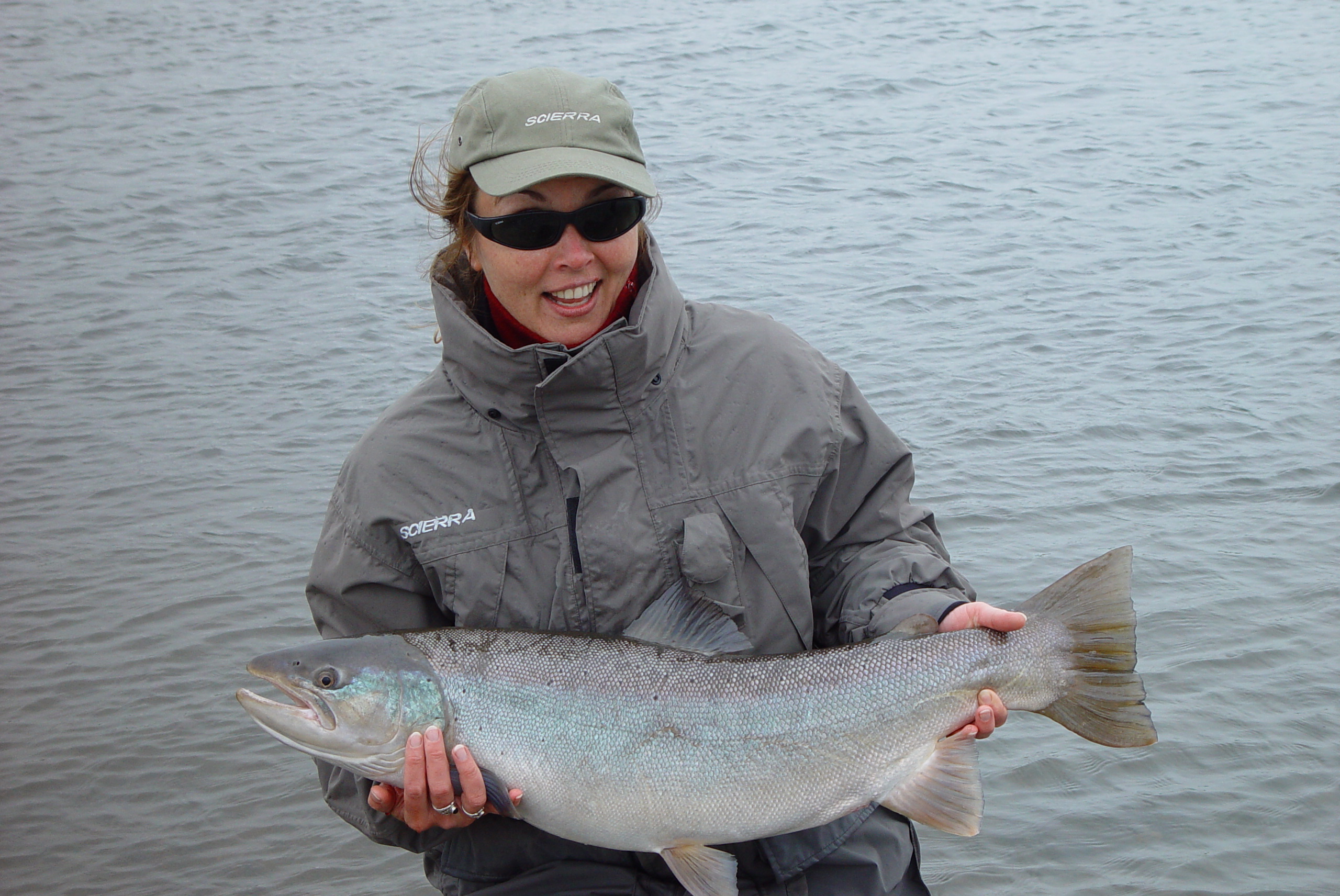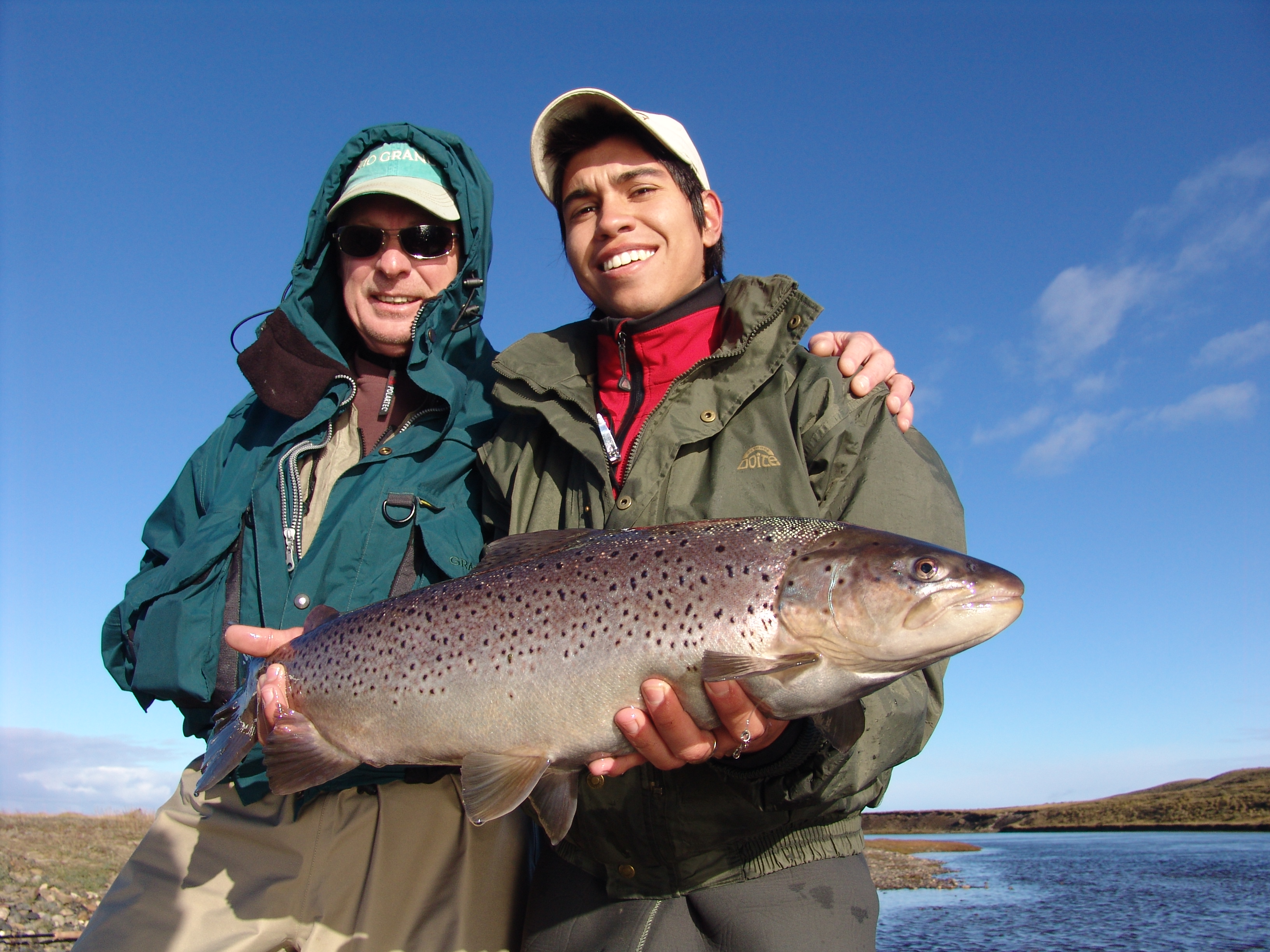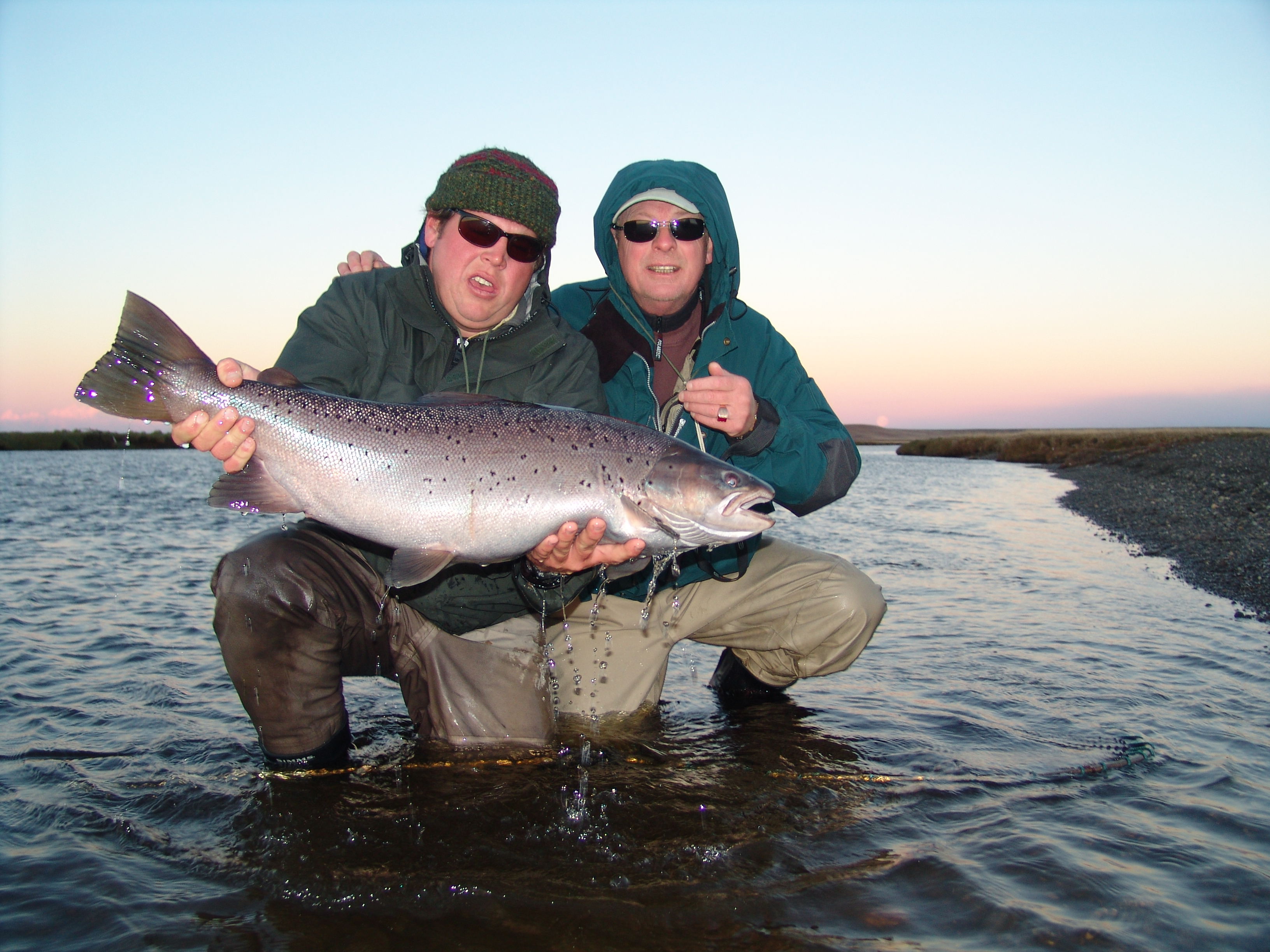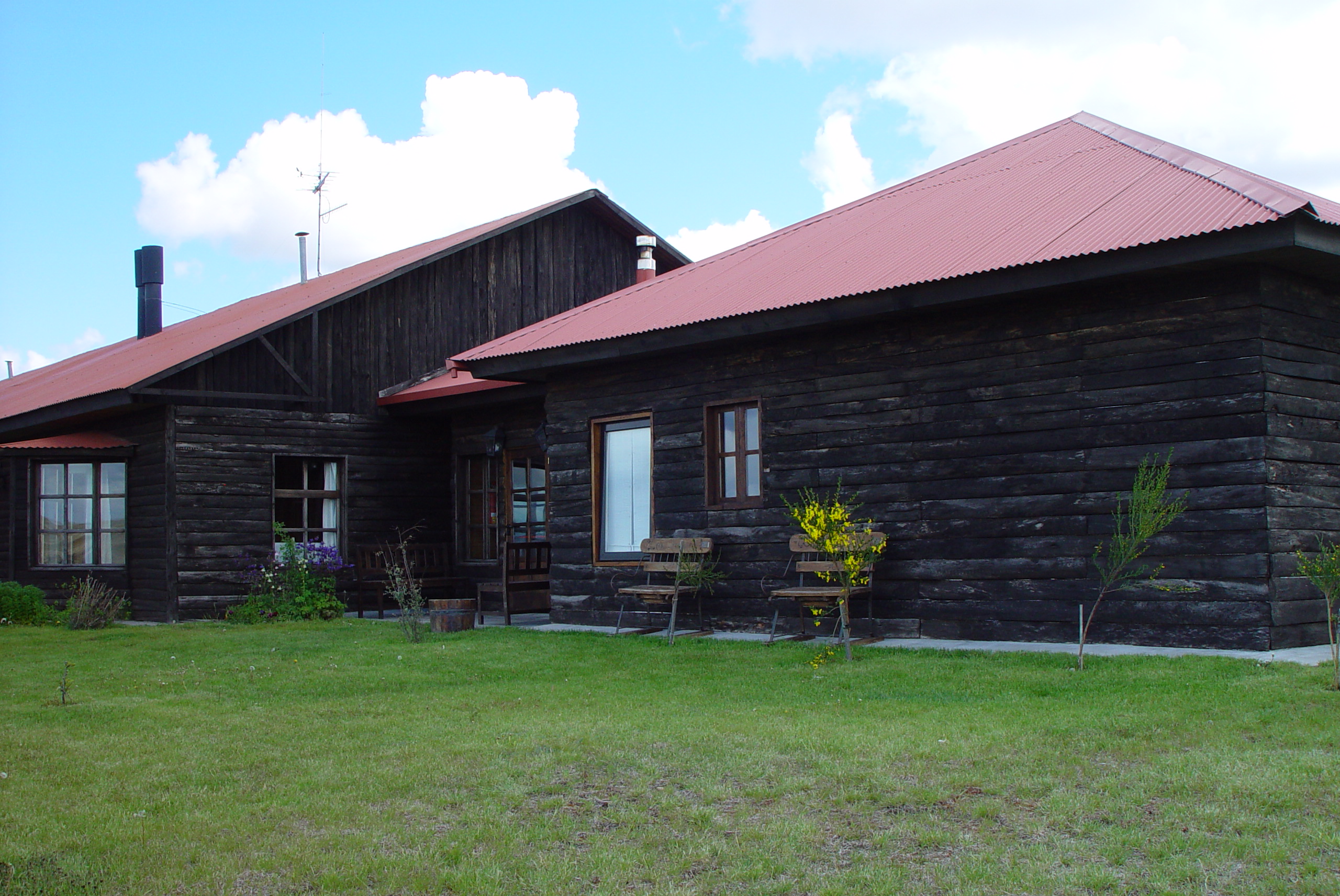
Kau Tapen is the first luxury lodge on the Rio Grande and was built in 1983. It sets a standard of elegance by which other lodges are measured. Every convenience one could imagine is at your fingertips. The lodge accommodates up to 12 guests in 8 twin bedrooms and 1 double bed room.
Kau Tapen lodge was designed to offer rods maximum comfort during their fishing trip, as well as easy accessibility to the pools.
* It accommodates up to 12 guests in 8 twin rooms and 1 double bedroom. It also boasts two well-placed and convenient heated wader rooms for wet gear, a wonderfully relaxing cedar Sauna, a Finnish steam bath, massage room and shower lounge for pure relaxation on terry cloth lounges out of the mainstream of activity. A great spot for some wonderful Argentina Malbec after a hot soak.
Not enough can be said for the outstanding staff service, gourmet offerings at every meal, fine wines, and fluffy down comforters that make any siesta especially welcome.
And the fishing for Sea Run Trout can simply not be matched anywhere on Earth. The trout range from 8-30 pounds and can take you into your backing on a long run as well as any fish in the world.


Rods
We’ve tested many rods on the Rio Grande. For a single-handed rod, we’ve found a 9, 91/2 or 10 footer for a No. 8 line to be about ideal for covering the water and for optimal sport. A rod of this size makes casting easy with the normal downstream southwest wind, while an 8 or 9- weight helps you to drive your line into a contrary wind when necessary. Given the Rio Grande’s moderate flow and generally even gravel bottom, you’ll find an 8 or 9 capable of doing battle with even the river’s largest sea trout (15 to 25 plus lbs.), while it insures the most action with smaller sea trout (4 9 lbs.). Light two handed rods are increasingly popular and allow anglers to cast a comfortable line with less effort, particularly on windy days. Mending and controlling line is also easier with a 2-hander. We encourage you to bring one of 13 to 15 feet for a 9-11weight line. If you are new to 2-handers, our guides are expert instructors and will help you learn quickly. Among rod makers Loop, Sage, Thomas & Thomas, Scott and G.Loomis are excellent choices for Rio Grande fishing. It makes sense to bring a back-up rod as well.
A quality reel is crucial for playing big sea trout. A strong, smooth drag is a must. Reels (and spare spools) should have capacity for the fly line and 100 yards of 20 pound backing. Appropriate reels include Loop,Abel, Tibor, Hardy, Lamson, Scientific Anglers, Ross, Etc.

Lines
To be well prepared for Tierra del Fuego, anglers should include at least three lines to accommodate variance in water levels and wind conditions. Weight forward fly lines are generally used on the Rio Grande. Floating lines are typically most useful in low water conditions and during early morning and evening hours, when sea trout are inclined to be nearer the surface. Also a sinking shooting taper is very important. The Teeny T-200 and T-300 lines have proven to be excellent, and at least one or both of these lines should be considered as must-bring items. Sinking tips, and sinking poly-leaders are also used a lot. Intermediate lines are also effective in some conditions.
Even experienced anglers often find their running line snarls when buffeted by wind. Prevailing southwest winds can be “harnessed” by roll casting or spey-casting, which eliminates the need to back-cast – difficult with a trailing wind. We found that a simple roll cast carries even large streamers 35 to 50 feet across and downstream, or far enough to cover the holding lies.
Weight forward lines you can roll cast effectively by stripping and shooting the line during the cast.
LEADERS
Experience on the Rio Grande indicates that sea trout aren’t particularly leader shy. While reasonable stealth should be exercised, your chief concern is to bring mono-filament in sizes that will turn over the array of fly sizes and patterns you’ll be using. Spools of mono should include 15, 12 and 10 lbs breaking strengths. Whilst fishing sinking lines, made-up leaders aren’t necessary since a few feet of mono will do fine. Maxima Ultra-green is a good choice as it has plenty of stretch a factor worth considering when the sea-trout of a lifetime hits your fly!
While fishing, be sure to check your mono regularly for casting knots and abrasions, and after each fish caught test your leader knots. For floating lines it’s good to have knot-less tapered leaders from 9 to 12 feet with 0X tippets.

FLIES
Some fly patterns as well as a modest supply of back-up tackle will be available for purchase at the lodge, but plan to take a good selection.
Sea run brown trout are mysterious fish. The only constant in their tastes seems to be a penchant for black, and the trout that accepted your small salmon patterns today may demand flies with white rubber legs tomorrow. Historically, most Rio Grande fish were taken on large streamers, perhaps because those were the patterns most used. In low water conditions, however, more large sea trout are taken on smaller wets, nymphs and dry flies. We suggest packing a range of flies in various patterns and sizes, and urge frequent changes when one combination of line and fly isn’t working, depending on light conditions, water levels, and especially on your guide’s advice. Barbless hooks are strongly encouraged. Double and treble hooks are not permitted.
Basic working fly list:
* Collie Dog tube flies (31/2 -41/2″ long, both aluminum and copper bodies, with hard plastic tubing and #4 wide-gape hooks)
* Bunny leech, Zonker, Woolly Bugger (black/olive), articulated string leech types, with electric blue flash, on #2-4 hooks
* Peacock (now a staple on Rio Grande, tied on #2-4 hooks)
* Girdle or Yuk Bug rubber legs (#4-12)
* Bitch Creek nymphs (orange and black for preference, #4-12)
* Bead head nymphs (Prince, Hare’s Ear, etc. #10-14)
* Traditional Atlantic Salmon Flies
* Bombers or other waking dry flies (natural deer hair, black&green on #4-8 hooks), for use drifted or with a Portland hitch
* Include 11/2 2 inch tube flies if you have them, as tubes can be very effective on the Rio Grande.
* Also, take any large, dark trout or salmon fly in which you have confidence. Fishing a fly that has worked for you in the past, and in which you have confidence, is half the battle.
Note: Larger streamers should be weighted and all should be tied on heavy hooks with good gapes. Treble & Double hooks are not allowed on the Rio Grande.
WADERS
* Wading isn’t difficult on the Rio Grande. However, we recommend chest waders for warmth, to get to that occasionally fished cut bank, and to manage deeper water when crossing the river.
* Capilene fleece pants are a must worn under Gore-tex waders, given that water temperatures can be in the 40’s (F). Thick wool or capilene fleece socks are also a must, and long johns might also be required.
* The river’s gravel bottom isn’t mossy but you might find that the security of felt soles aids in concentrating on casting and playing fish by keeping your mind off your feet. So a good pair of wading boots are a must, with felt soles or rubber cleats .
* use gravel guards and be sure to bring a wading belt.
* A wading staff is optional, but can come in handy during very windy days.
FISHING METHODS

Although most of their lives are spent in the ocean, the sea run brown seem to retain more of the eccentricities of resident browns than, for instance, steel-head do of resident rainbows.
Moody fish, they must be shown flies the way they want to see them at the precise time, that they’re ready to take.
The Rio Grande isn’t a big river. Thus, it’s compatible with a wide range of techniques, critical since a large sea trout may demand that a fly be fed to it on the bottom one hour but rise to the Portland Hitch the next. Water levels can change from week to week and the water generally drops as the season progresses. Vary your presentation markedly in each pool fished until you find the right formula of fly, line, (see Lines) drift or swing, and retrieve. Pay close attention to the advice of your guide, whose primary aim is to recommend the methods that will help you hook and bring your fish to the net.
Generally, the Rio Grande’s sea trout seem to lie near cut banks during the middle of the day, though in low water they will also lie in the faster necks of pools. Naturally, they move up primarily during early morning, evening and nighttime hours. Generally, “tails in the morning and heads at night” is a good rule. Also look for fish distributed throughout pools on calm, overcast days. Therefore, try to begin each fly drift or swing as close to a cut bank as possible, whether the presentation is upstream and across, straight across, or downstream and across. On sunny days, one theory holds that sea trout will take best if they don’t have the sun in their eyes, although this theory, like others, is often affected by the number of fish in a particular pool and the number of “takers.”

THE DAILY PROGRAM
* Guests will leave the lodge around 9 o’clock after breakfast, fishing till around 1 o’clock.
* Following lunch and a siesta,(the hours of which will depend on the season) Guests return to the river between 5 and 6 o’clock and fish through till dusk. Fishing hours will change slightly depending on the time of year.
GUIDES
* Kau Tapen has a team of experienced, professional international guides.
* They are all English speakers, and will be able to offer tips on how to best fish each pool, fly choice and presentation.
* They are there to make your fishing more productive and enjoyable.

VEHICLES
* Guides will transport you to the river in comfortable 4WD vehicles
* All are equipped with rod racks, first aid equipment and VHF radios.
ADDITIONAL TIPS
1. If you have questions, ask your guide. They know the river well and can usually give you the best recommendation on how to approach a particular fishing situation.
2. Fishing days are long, especially early in the season, and the climate can be difficult. Concentrate your fishing during periods when trout are taking, and don’t hesitate to rest at midday. If you find that you tire as the week progresses, talk with your guide about departing for the river a bit later; they will be happy to accommodate you.
3. As a rule, the more time your fly spends in the water, the more sea trout you’ll catch. You’ll want to minimize false casting in order to cover as much water as possible during each outing. One retrieve technique commonly employed is short strips, but since pools and fly types vary it’s best to consult your guide on how best to fish each new situation and which retrieve to employ. Point your rod tip to where your fly line enters the water, following the line around as it swings your fly while you retrieve it. Depending on the swiftness of the current you may want to mend your line upstream, occasionally even downstream, in order to present your fly most advantageously to the trout.
4. Check leaders regularly for wind knots, which halve the breaking strength of monofilament.
5. If you have a fish roll at the fly, follow or “bump” it in any way; there is a good chance that the trout will come back to the same or a different fly. Wait a moment for the fish to return to its lie, don’t move, and cast again to the same location. Try to repeat the same length cast and fly speed. Then, change speed and fly on the next several casts. If the trout does not show himself again after a few changes, mark his location and return to try him again after resting that portion of the pool.
6. In setting a hook it’s best simply to tighten and let the fish hook itself. Never jerk the line to set a hook.
7. Having hooked a large fish, don’t plant your feet and attempt to drag it upstream against the current. Once you have the trout under control, head for shore and move with your fish, staying either abreast or slightly downstream of it. Also remember to “bow” to jumping sea trout by lowering your rod tip as the fish leaves the water.
8. Play sea trout aggressively, much as you should Atlantic salmon or steelhead. Many anglers play large fish too gingerly, which causes more losses than bullying the fish.
9. If you hook a fish in low light, communicate with your guide immediately. Listen carefully to his instructions, particularly with regards to the most reliable spot to net your fish.
10. Handle all fish with care and release them unharmed. (All fishing on the Rio Grande is catch and release.) Try not to let your trophies thrash on the bank. For pictures, cradle the fish in wet hands, gripping the handle of the tail firmly.

CATCH & RELEASE
* Kau Tapen promotes a strict catch and release policy, which has over the years helped the increase in numbers of returning fish.
* The mortality rate of released fish is almost non existent, and these fish do not die after spawning. Catch and release hugely increases the chances of that fish returning to the river.
* We ask that all fishermen de-barb all flies. Not only do barbless hooks penetrate more readily, allowing for more successful hook-ups, but they are also more easily removed, should a cast go errant.
* Guides are equipped with large nets featuring in-built scales. They are trained to land your fish, weigh it and measure it, and release it undamaged.
* If you are landing your own fish, hold it facing the current, and avoid moving it back and forth in the water. You may have to hold it in this position for a good while. Be patient, only when a fish is thoroughly rested should it be allowed to swim away.
SAFETY EQUIPMENT
* For eye protection, sunglasses should be worn while fishing the Rio Grande. Polaroids and a fishing hat with a brim that will protect your eyes and ears make an ideal combination. Also for safety, sea trout anglers should pack yellow or clear protective glasses. Yellow brightens the dusk sky. Anglers who wear prescription glasses should pack prescription polaroids and back ups.
* Guides are well-prepared to handle emergency medical situations, but you can take a few Band-Aids for cuts, scrapes and blisters. Many anglers like to tape their stripping finger with electrical tape which will avoid nasty cuts.
LICENSES
All information necessary to obtain your license (no additional cost) will be taken from your pre-trip questionnaire. Please make sure you send it back filled in.

THE LODGE
* Built in 1983, Kau Tapen lodge was designed to offer rods maximum comfort during their fishing trip, as well as easy accessibility to the pools.
* It accommodates up to 12 guests in 8 twin rooms and 1 double bedroom.
* A large living room area opens up to vista’s of the Menendez Valley and Rio Grande valley.
* A large roaring fire and well stocked bar will welcome you after every fishing session.
* The lodge has a tackle shop with a good selection of Sage rods, good quality reels, flies, lines, and clothing equipment, especially selected to suit the needs of your trip.
* In addition, guests have the full use of the lodge’s fly tying table and equipment.
* The lodge has 2 wading rooms, a sauna, Finnish steam bath and Massage room.
FOOD & DRINK
Kau Tapen offers wonderful cuisine based on local meats, fresh vegetable and delicious deserts. A traditional Asado (BBQ) will be held once during your stay, and you can sample different cuts of meat and wonderful salads.
A full cooked breakfast is available, together with fresh fruit, yogurts, home baked breads and jams and a selection of cereals Kau Tapen’s cellars feature a wonderful selection of fine wines from the Luigi Bosca Bodega, wich will be served during lunch and dinner.
ELECTRIC CURRENT
* 220 volts, 50 cycles, generator powered.
* a standard converter and European adapter for two pronged plug should work fine throughout Argentina.
* The lodge has reliable electric power and back-up battery lighting.
 |  |
 |  |
Location
* The lodge is located on the banks of the Rio Grande, in Tierra del Fuego, Argentina
Getting there
* Guests fly into Argentina via Buenos Aires and typically overnight there, having spent a day touring this wonderful city. Arrival day at Kau Tapen is set to Saturdays, so the following morning guests depart Buenos Aires for the flight south.
* Commercial airlines fly from Buenos Aires to the airport of Rio Grande (3 hour flight), where you will be met by a lodge representative.
* The transfer from Rio Grande airport to the lodge by four wheel drive takes 1 1/2 hours.
* On arrival at the lodge, guests are welcomed with cocktails and the entire Kau Tapen staff.
Travel Documents
* You will need a valid passport to travel to Argentina.
* No Visa is required for US or UK passengers, but other nationalities should check with their local consulate..
Health concerns
* No innoculations are required to enter Argentina.
* Rio Grande has a modern private clinic and Buenos Aires offers first class hospital care in case of an emergency
* The sun and wind are very strong in Tierra del Fuego. Total sunblock is HIGHLY recommended
* There are no problems with drinking water, and the lodge serves drinkable well water. Bottled water is always available.
* Mosquitoes and bugs are not a problem in Rio Grande
* If you have a health condition, please make sure to bring ALL the medication you will require for your stay.
* Please notify the lodge of any health conditions or concerns we should be aware of. You can do this with the questionnaire provided Kau Tapen Lodge Rio Grande Argentina
* The lodge has a basic first aid supply , but do bring any item you think you might need. As with all destination travel, you should be covered by a general Health and Travel Insurance policy before you fly. As with all destination travel you should be covered with a general health and travel insurance policy before you fly.
Climate
* The Sea trout season runs from November to mid April.
* December and January are the warmest months, and traditionally the windiest. The sun can be strong during the day, but the wind chill factor makes the use of protective gear necessary all season long
Clothing
The summer climate of this southernmost region of South America is extremely changeable, and a wide range of temperatures and weather conditions should be expected. We recommend layering clothing, enabling you to add or subtract garments during the day. Pack Polar fleece jackets, thermal underwear, Polar neck, wool socks and a wool cap to be prepared for the extreme. Flannel or chamois cloth shirts and Polars are ideal for the stream, although you’ll no doubt change to something lighter while in the lodge. Also take a reliable windstopper/rain jacket. Gore Tex is excellent. Its waterproof yet breathes and so is comfortable on sunny, windy afternoons. Simms Gore-Tex and Patagonia SST wading jackets are popular. Most first-time visitors are surprised at how dry this region is, more reminiscent of Wyoming than of Scotland.
Attire in the lodge is casual. Neat but casual is also the dress style in Buenos Aires. Laundry service is available at the lodge.
Medication
* Travelers should always pack medication for such common complaints as diarrhea, upset stomach, motion sickness, headache and irregularity, along with prescriptions.
* Most visitors to Argentina don’t experience stomach problems associated, for instance, with Mexico, but it pays to have treatment available just in case.
* You’ll find food to be outstanding, and bottled water available everywhere in Argentina.
Miscellaneous
Insects are not a problem in Tierra del Fuego. Be sure to bring and use sun block (15-30), even on cloudy days, and also lip cream, depending on your sensitivity. (The sun is very strong!)
Camera and film, and a small carrying bag, (tackle bag or backpack) for odds and ends. Most of the fishing on the Rio Grande is near the vehicle. Items such as extra jackets, vests and tackle can be left in the vehicle each day between fishing periods. Small pliers are handy for debarbing hooks and releasing fish. Don’t forget angler’s clippers, and dry fly floatant, also line dressing, a small flashlight for evening fishing, a hook sharpener, and Polartec or neoprene (fingerless) fishing gloves.
Note: Rods and reels ride assembled on top of the vehicle to and from the river and between beats each day, often in dusty conditions. To protect your valuable reels, bring neoprene or some type of close-fitting reel cover that can be easily removed.
Emergencies
* Kau Tapen lodge has a telephone and internet services for guest use.
* You will find all the relevant contact details in your final itinerary, a copy of which you can leave with a family member in case of emergency
* Your pre-trip questionnaire should indicate a contact in case of emergency, which is forwarded to the managers of Kau Tapen lodge
Gratuities
The guide and staff at Kau Tapen work hard to provide you with the best experience during your trip. Gratuities are discretionary, and show your appreciation with the standard of the services provided. They are much appreciated by all. A typical weekly gratuity for guides and staff per person per week ranges from $350 to $500. The tip pool will be divided by managers amongst all the staff at KAU TAPEN




